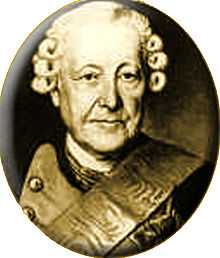Hans von Lehwaldt

Hans von Lehwald(t) (24 June 1685 – 16 November 1768), also known as Johann von Lehwald(t), was a Prussian Generalfeldmarschall who participated in the Silesian Wars of Frederick the Great.
Life
Lehwaldt was born in Legitten near Labiau in the Duchy of Prussia. His mother Marie Esther came from an old Prussian family, the Freiherrn von der Trenck.
In 1699, Lehwaldt began his military service when he entered the battalion "Weiße Grenadier-Garde" (Nr. 18). He participated in the War of the Spanish Succession since 1702 and experienced his trial by fire in the September siege of Venlo. In spring 1704, his battalion fought in the Battle of Blenheim, and Lehwaldt was promoted to Fähnrich on 16 September. From 29 September – 6 October he participated in the siege of Hagenau.
King Frederick II of Prussia awarded Lehwaldt the Pour le Mérite in 1742 after the First Silesian War and the Order of the Black Eagle on 4 February 1744. Lehwaldt defeated the Austrian forces of Georg Oliver von Wallis near Habelschwerdt on 14 February 1745, during the Second Silesian War. Lehwaldt was promoted to Generalfeldmarschall on 22 January 1751. Frederick the Great also awarded him a diamond-covered portrait of the king on a blue band. Wilhelm Dietrich von Buddenbrock and Friedrich Wilhelm von Dossow were the only other recipients of the medallion. As political tensions mounted in 1756, Frederick sent Lehwaldt, the commander in East Prussia, one hundred officers' patents to fill as he saw fit.[1]
Lehwaldt was in charge of the East Prussian defense against the Russian Empire upon the outbreak of the Seven Years' War (1756–63). The Russian field marshal Apraxin tried to encircle the Prussians with his larger army, which Lehwaldt was able to avoid. Apraxin began to march on Königsberg, as his troops lacked supplies and suffered attrition. Lehwaldt's 30,000 troops intercepted 80,000 Russians at Gross Jägersdorf, with Lehwaldt losing 4,600 casualties and Apraxin 7,000.[2] Although Lehwaldt withdrew his corps from the battle, the Russians were unable to follow upon the victory. Apraxin retreated from the province after hearing a false report that Empress Elizabeth of Russia had died. Von Lehwaldt then oversaw the Blockade of Stralsund, keeping Swedish forces pinned down on the Baltic Sea.
Because of his poor health, Lehwaldt was transferred to Berlin, where he became governor of the city in 1759. Lehwaldt and Seydlitz, both invalids, were unable to resist the capture and looting of relatively defenseless Berlin and Potsdam in October 1760 by 15,000 Austrians, 18,000 Russians, and 5,600 Cossacks.[3] Lehwaldt died in Königsberg in 1768 and was buried in the Juditten Church.
Footnotes
References
- This article incorporates information from the revision as of December 8, 2007 of the equivalent article on the German Wikipedia.
- MacDonogh, Giles (2001). Frederick the Great: A Life in Deed and Letters. New York: St. Martin's Griffin. p. 436. ISBN 0-312-27266-9.
Further reading
- Joachim Engelmann und Günter Dorn: Friedrich der Große und seine Generale, Friedberg 1988. (German)
- Bernhard von Poten: Lehwaldt, Hans von. In: Allgemeine Deutsche Biographie (ADB). Bd. 18, S. 166–67. (German)
|